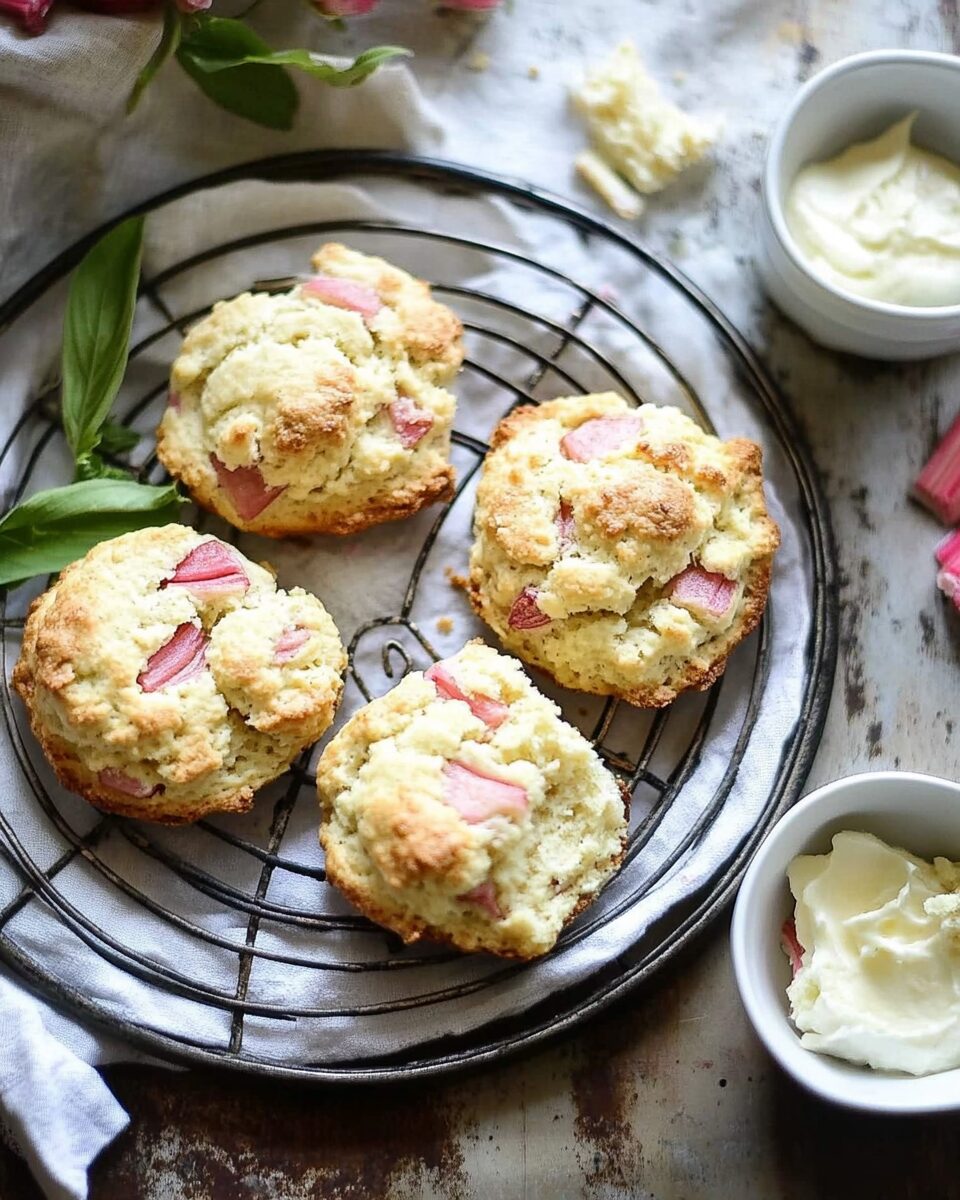Rhubarb Scones: A Delightful Blend of Sweet and Tart
When it comes to baked goods, few treats capture the essence of spring and summer quite like a warm, flaky scone. And when you introduce the vibrant and tart flavor of fresh rhubarb into the mix, you have a combination that’s nothing short of extraordinary. Rhubarb scones strike a perfect balance between the buttery richness of the scone dough and the tart, fruity punch of the rhubarb. These scones are not only easy to make, but they also offer a unique twist on a classic British favorite.
In this article, we’ll explore why rhubarb scones should be a part of your baking repertoire, the history behind rhubarb, some baking tips for perfect scones, and creative ways to serve them.
The Story of Rhubarb: A Brief History
Rhubarb has a fascinating history that goes far beyond its use in desserts. Originally, rhubarb was cultivated for medicinal purposes, dating back thousands of years in China. It was highly prized for its use as a laxative and in various medicinal concoctions. In fact, rhubarb was so valuable in ancient times that it was traded at a premium. It wasn’t until the 18th century that rhubarb found its way into the kitchens of Europe and North America, where its tart flavor was appreciated in both savory and sweet dishes.
By the 19th century, rhubarb had become a staple ingredient in desserts, particularly pies, jams, and compotes. Today, it’s often paired with strawberries in recipes, but its versatility as a stand-alone fruit (technically a vegetable, though treated as a fruit) makes it perfect for a variety of baking applications, including these scones.
The Perfect Scone: Flaky, Buttery, and Light
Creating the perfect scone can seem like an art form, but with a few tips, anyone can make a batch of light, flaky, and flavorful scones. The key to achieving the right texture in a scone lies in a few simple principles:
-
Cold Butter: The butter must be cold when it’s added to the dry ingredients. Cold butter creates pockets of air as it melts during baking, resulting in a flaky texture. Use a pastry cutter, fork, or your hands to incorporate the butter into the dry ingredients without overworking the dough.
-
Minimal Mixing: Scone dough should be mixed as little as possible. Overworking the dough can cause the scones to become tough. Once the wet and dry ingredients are combined, it’s important to handle the dough gently and minimally.
-
Chilled Dough: After mixing, it’s often helpful to chill the dough for 15-20 minutes. This helps the butter firm up again and ensures a flaky texture when baking.
-
Cutting the Dough: When cutting the dough into wedges, be sure to use a sharp knife or bench scraper. A clean cut ensures that the scones rise evenly without becoming misshapen.
-
High Oven Temperature: Scones bake best in a hot oven. The high heat encourages the scones to rise quickly, creating a light and fluffy interior. Make sure your oven is preheated to the right temperature before you bake your scones.
Why Rhubarb Works So Well in Scones
Rhubarb’s distinctively tart flavor is what makes it an ideal addition to scones. Many scone recipes call for fruits like raisins or currants, which provide a burst of sweetness. In contrast, rhubarb adds a sharp, tangy contrast to the richness of the scone dough, which is often buttery and slightly sweet. The result is a well-balanced pastry that excites the taste buds and pairs perfectly with a hot cup of tea or coffee.
Fresh rhubarb works best in scones, as it retains its natural crunch and tartness when baked. You can also experiment with substituting other fruits or berries if you’re looking for a variation, but rhubarb’s tartness makes it a standout choice.
Variations and Pairings: How to Customize Your Rhubarb Scones
While rhubarb scones on their own are a treat, there are endless ways to customize the flavor and presentation to suit your preferences.
-
Add Spices for Extra Warmth: To enhance the scones’ flavor, consider adding a pinch of ground ginger, cinnamon, or cardamom to the dry ingredients. These spices complement the tartness of the rhubarb and add a cozy, aromatic touch to your scones.
-
Glaze for a Sweet Finish: For those who prefer a touch of sweetness on their scones, a simple glaze made with powdered sugar and milk can be drizzled over the top. A lemon glaze pairs particularly well with rhubarb, balancing out its tartness with a bright citrusy flavor.
-
Serve with Clotted Cream or Jam: Rhubarb scones are delicious on their own, but they can be elevated when served with clotted cream or homemade jam. Rhubarb jam, in particular, is a fantastic pairing as it brings out the flavors of the scone and adds an extra layer of sweetness. If you’re feeling adventurous, try a strawberry rhubarb jam for a double hit of fruit.
-
Add Nuts or Seeds: For an extra crunch, try adding chopped nuts such as almonds or walnuts to the dough. You can also sprinkle seeds on top before baking to give the scones a rustic finish.
-
Make Them Vegan: If you prefer a dairy-free or vegan version, substitute the butter for a plant-based alternative like coconut oil or vegan butter. Swap the buttermilk for almond or soy milk to make these scones suitable for all dietary needs.
Why Rhubarb Scones are Perfect for Any Occasion
Rhubarb scones are incredibly versatile and can be enjoyed in many different settings. Whether you’re hosting an afternoon tea, enjoying a cozy weekend breakfast, or serving them at a brunch gathering, these scones are guaranteed to be a hit. Their elegant yet rustic presentation makes them a perfect addition to any table, and they’re simple enough to prepare without much fuss.
They also make a wonderful gift! Wrapped in a decorative bag or box, these homemade scones are a thoughtful and delicious present for birthdays, holidays, or any special occasion. Add a jar of homemade rhubarb jam or a small bottle of clotted cream, and you’ll have the perfect gift for any baking enthusiast or lover of classic British treats.
Rhubarb Scones: A Perfect Spring and Summer Treat
Rhubarb is a seasonal delight, and making rhubarb scones is one of the best ways to enjoy it when it’s at its freshest. These scones bring the brightness of spring and summer into your kitchen, and their delicate balance of flavors makes them ideal for a sunny afternoon.
Whether you’re a seasoned baker or someone just starting out, these scones are simple to make and offer an impressive result that’s sure to please. Once you’ve tried these rhubarb scones, you may find yourself baking them regularly as they’re bound to become a new favorite.
Conclusion
Rhubarb scones are a timeless treat that combines rich, buttery scones with the tart freshness of rhubarb. They’re perfect for breakfast, brunch, or as a delicious snack paired with your favorite beverage. The versatility of rhubarb makes it an excellent choice for a wide variety of recipes, but these scones, with their flakiness and subtle sweetness, stand out as one of the best ways to enjoy this vibrant vegetable-turned-fruit.
By following a few simple baking tips, you can make perfect scones every time. From the right temperature for your butter to the magic of a hot oven, these tips will ensure that your rhubarb scones are light, fluffy, and flavorful. Enjoy experimenting with different variations and toppings to make these scones your own, and don’t forget to share them with friends and family for a true treat!






